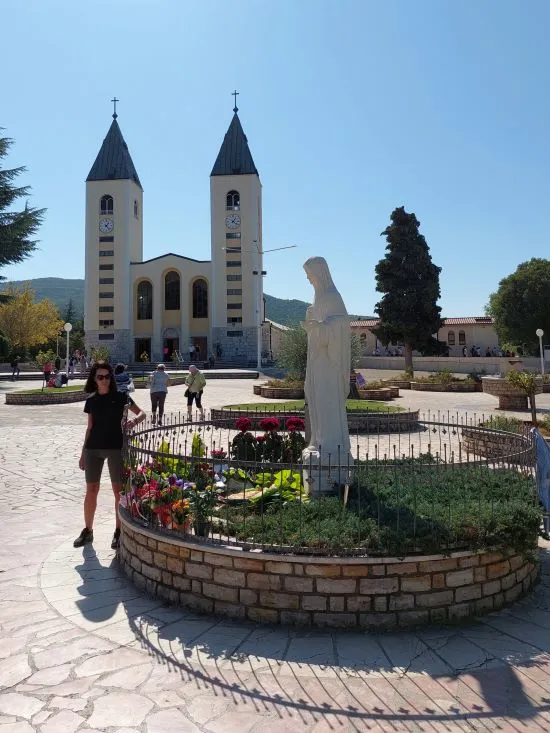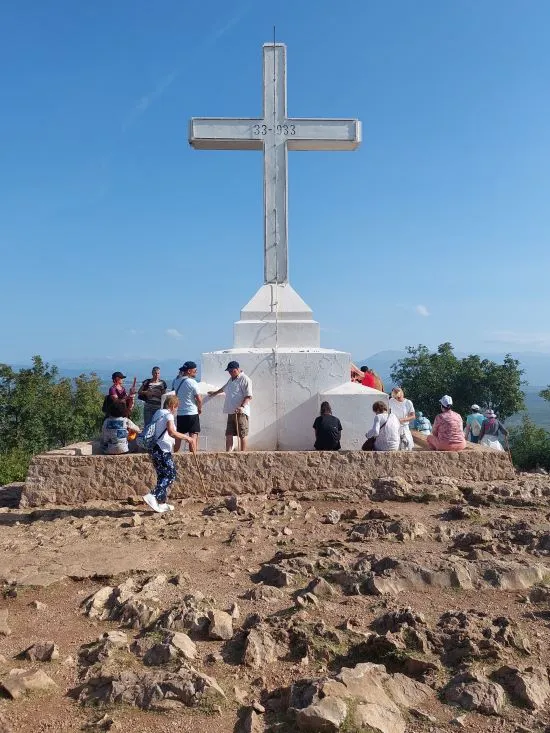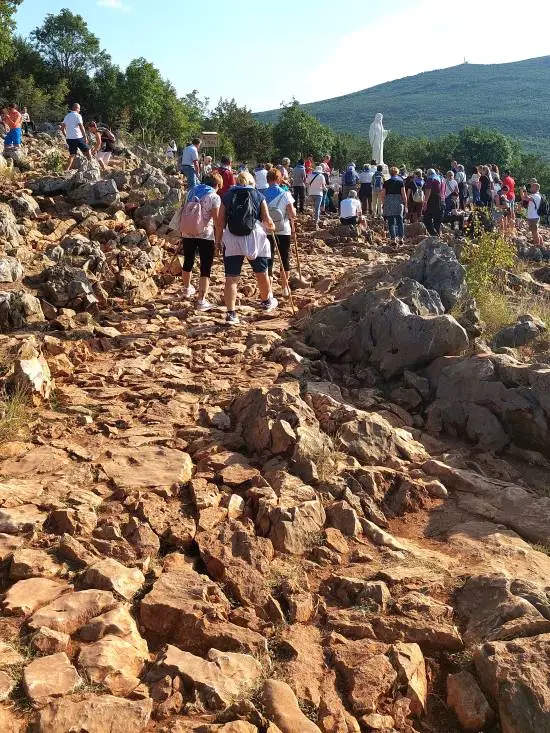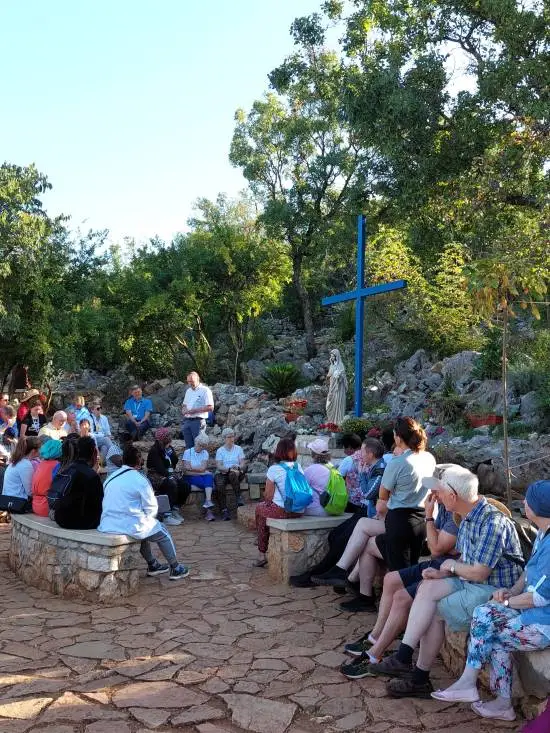Important locations in Medjugorje
Contents
Saint James's Parish Church

St. James's Church is the most important location in Medjugorje.
It serves as the centre of the sacramental, prayer, and spiritual life in Medjugorje, for the local parishioners and also for the millions of pilgrims from around the world who visit Medjugorje.
The parish of Medjugorje was established on the 15th May 1892, and was placed under the patronage of St. James the Apostle, the patron saint of pilgrims. The parish is cared for by Franciscans from the Franciscan Province of Bosnia Srebrena.
A well-known architect from Zagreb, Stjepan Podhorski, donated his services to design the present-day church. After the parish obtained permission from the local bishop, construction of the new church commenced in June 1935, but due to the interruption of the Second World War, further construction was postponed. The construction work for the main structure was completed in 1968 and the church was consecrated on the 19th January 1969. Further interior work and the bell towers were completed by 1980.

Above the main entrance door to the Church there is a relief depicting St. James. The plain interior is divided into seven vaults, which are divided internally by beams and pilasters. The seventh vault is separated towards the semicircular apse by a round triumphal arch.
Despite its rural location at the time, the church was constructed with an unusually large capacity for the area, with the ability to accommodate over two thousand people. The reasons behind the decision to build such a spacious church and dedicate it to the Apostle St. James the Greater, the patron saint of pilgrims, point to the conclusion that even then, Our Lady was preparing the parish of Medjugorje for its special role.
The apparitions of Our Lady have occurred at various locations throughout Medjugorje, including St. James's Church. The first apparition within the actual parish grounds, took place in a small room to the right of the church's altar. For three years, this side room became a regular site for the apparitions, followed by Fr. Slavko's office in the old rectory, and later in the choir gallery of the Church. Apparitions have also occurred in the Adoration Chapel adjacent to the church.
In 1987, Croatian artist Branimir Dorotic created stained glass windows that are installed in the Church. On the righthand side of the church, when facing the altar, these windows display 14 scenes from the life of Our Lady, while the windows on the on the lefthand side of the aisle depict scenes related to the apparitions of Our Lady in Medjugorje.
Also, in 1987, Italian artist Dino Felici completed a marble statue of Our Lady, Queen of Peace, which is situated in the plaza in front of St. James's Church. The statue is surrounded by flower beds and a decorative wrought-iron fence.
A bronze Statue of Saint Leopold Mandić is located near the confessionals to the Western side of the Church. St. Leopold is designated as saint-confessor to inspire people to become reconciled to the Church and to God. St. Leopold also had a deep devotion to the Blessed Virgin Mary who he referred to as “my holy boss”. His statue is also a popular meeting point for pilgrims in Medjugorje.
The main confessional boxes are provided on the western side of the Church, with further confessional boxes on the Eastern side. To the Eastern side is also the Candle Park, where votive candles are available for lighting, and where toilets and washrooms are also available.
To accommodate the growing number of pilgrims, an exterior altar and canopy were constructed in 1989. The surrounding outdoor prayer area, with seating for approximately 5,000 pilgrims, serves as the gathering place for the evening prayer programme during the main pilgrimage season and for major feast days when thousands of pilgrims come to Medjugorje.
Cross Mountain (Križevac)

In 1933, Pope Pius XI proclaimed a Holy Year to mark the 1900th anniversary of the crucifixion, death and resurrection of Our Lord and Saviour. The Pope also had a dream that a cross was to be raised on the “highest Golgotha in Herzegovina.”
Fr. Bernardin Smoljan was the Parish Priest in Medjugorje and on the 21st January 1934 he decided to build a cross to commemorate the anniversary and to respond to the Holy Father's call. Voluntarily, the parishioners climbed the 420 metre high mountain, which is difficult rocky terrain, carrying cement, sand, water, tools and all the necessary materials required to build the cross.
As a result of Pope Pius's dream, Fr. Smoljan and his parishioners were provided with a relic of the true Cross of Christ and this relic was built into the arm of the cross. This relic was obtained from the larger part of the true Cross that remains today in the Church of the Holy Cross of Jerusalem, in Rome.
The parishioners worked with great dedication and motivation in bitter conditions, and on the 15th March 1934, they completed the 16 tonnes, 8.5-meter high cross within 52 days. An entry in the parish records revealed that the parishioners performed this difficult task “in order to leave to their descendants a clear and visible proof of their deep faith in the Redeemer”. The cross was blessed on the 16th March 1934 and the first Holy Mass was celebrated there.
Before the erection of the cross, Medjugorje had experienced many thunder, lightning and hail storms and inclement weather that destroyed the crops of the parishioners. As a consequence, the parishioners suffered great hardship and loss of their already small income. Once the cross was built, the storms ceased.
In her message of the 30th August 1984, Our Lady, said of this Cross: “Dear children, the cross was also in God’s plan when you built it. These days especially, go on the mountain and pray before the cross. I need your prayers. Thank you for having responded to my call.”
Holy Mass is now celebrated twice a year on Krizevac. The first is on the feast of the Transfiguration (the 6th August) and the second is on the Feast of the Exaltation (the Triumph) of the Cross, which is on the first Sunday after the Nativity of Mary.
The following words are inscribed on the cross:
IHS
JESUS CHRIST
REDEEMER OF MANKIND
AS A SIGN OF OUR FAITH
OUR LOVE AND OUR HOPE
BUILT BY PASTOR BERNADIN SMOLJAN
AND THE PARISHIONERS OF MEDJUGORJE
FREE ALL OF US
FROM ALL EVIL
O JESUS!
. . on the back of the cross is marked the years
33-1933
There is also a monument near the top of the mountain to Fr. Slavko Barbarić, who served as the spiritual director of the visionaries from 1984 until his death in 2000.
Cross Mountain is a Holy place of prayer and silence and it is customary to pray and meditate on the stations of the cross that line the route as one ascends the mountain, and accompany the suffering of Our Lord as he carries his cross.
Apparition Hill

Apparition Hill (Podbrdo) is the location of the first apparitions of Our Lady in June 1981. A rocky path leads from the rear of the houses in the Bijakovići area of Medjugorje to the site of the apparitions.
Along the way are bronze reliefs representing the joyful and sorrowful mysteries of the Rosary. It is customary for pilgrims to pray the mysteries of the Rosary when ascending Apparition Hill.
Apparition Hill has become an important place of prayer for pilgrims. Many miraculous physical and spiritual healings have occurred there.
About two thirds of the way along the route a large wooden cross is erected marking the place where one the visionaries, Marija Pavlović, on the 26th June 1981, received the apparition; where Our Lady gave us her important call to peace for the first time. “Peace, peace, peace (Mir, Mir, Mir), and only peace! Peace must reign between men and God and among people"
At the end of the path on Apparition Hill a marble statue of the Queen of Peace has been erected at the exact location of the first Apparitions. This is also the location where Our Lady has promised in the future, as part of the 10 secrets, to leave a permanent, visible, indestructible sign for humanity that will prove that she has really been here among us over these years.
The statue of Our Lady was placed on Apparition Hill on 8th September 2001. The statue was transported up the hill by the residents of the Cenacolo Community. It is a copy of the statue of Our Lady that is found in the square in front of the parish church of St. James.
Both of these statues were sculpted by Italian artist Dino Felici. The Apparition Hill statue is a gift from pilgrims from South Korea in thanksgiving for the miraculous healing of a very ill child who was a pilgrim from South Korea.
The Blue Cross

At the foot of Apparition Hill is the Blue Cross. It marks the location where Ivan the visionary's prayer group has gathered regularly since the 4th July 1982.
There are in fact two blue crosses there, an upper one, and a lower one, placed very near to each other at the base of Apparition Hill.
The upper Blue Cross marks the original location of 1982, the lower Blue Cross was placed there in 1999.
On the 4th July 1982, as Ivan and his prayer group ascended Apparition Hill, Ivan suddenly had a vision, in which he was warned not to climb the hill with the prayer group, because 200 metres further ahead was an ambush set by several communist policemen with the intention of arresting the group. Instead, Our Lady protected the prayer group from being seen and told Ivan to meet there for prayer, so as not to risk arrest.
The Blue Cross marking this prayer group location was placed there in 1985. The Cross is blue for no other reason than it happened to be the colour available at the time to paint the cross using some leftover paint found in Ivan's father's shed!
The lower Blue Cross was erected in 1999 to commemorate Nedjo Brečić, Vicka's brother-in-law, who is a deceased member of Ivan’s prayer group. Nedjo died on the 4th July 1999, immediately after an apparition, and precisely on the anniversary of the founding of Ivan's prayer group.
The lower Blue Cross is also the location where the many apparitions of Our Lady with the visionary Mirjana took place on the 2nd of every month in the presence of thousands of pilgrims.
As with Apparition Hill, the Blue Cross has become a very important place of prayer for pilgrims, and many miraculous physical and spiritual healings have also taken place there.
Being easier to reach than Apparition Hill, the Blue Cross is an ideal place of prayer for those who, due to physical condition, or snow and frost, cannot climb further up the hill. Here too, as in the other places of prayer in Medjugorje the Rosary is prayed and has become another fitting location for personal reflection and prayer.